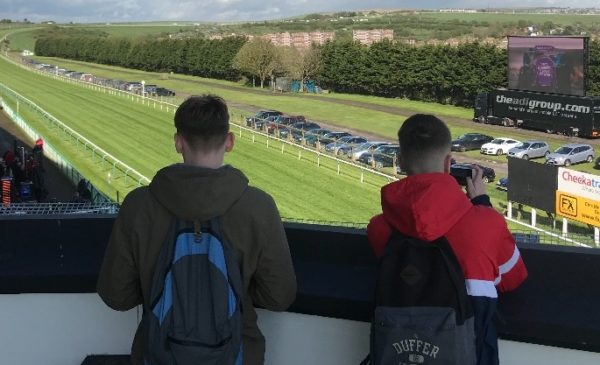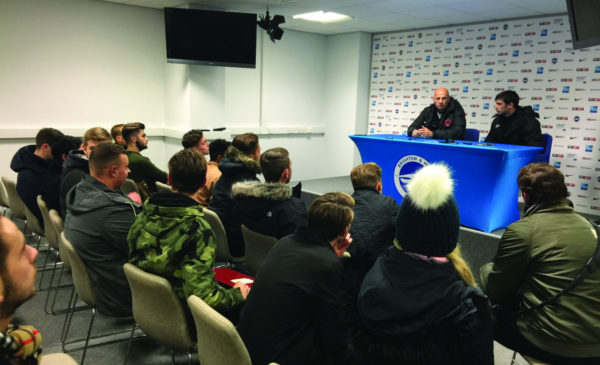By Joel Lushington
13/01/2021
The internet has certainly transformed journalism in its format and how events are reported on in sport. However, social media can often display a lot of news that is biassed, edited or in general, fake. With the billions of twitter users, the fake news can often overpower and hide the news that is real, because it might be what people want to hear, rather than the truth, because the truth can be dull to many who want stories that are so unique and surprising to them. The international Journal of Sport Communication features a section on how the media can deceive users, as well as how it has changed journalism. “The digitization of sport news means that content can be more easily produced, reproduced, transferred, and manipulated. Digital media reduce the cost of production and distribution of content; as such, anyone can be a content creator and distributor” (Mark Lowes 2018).
Social media such as twitter also allows millions of people to have a voice and opinion on sport, making a lot of journalism free and a lot less profitable than journalism from broadsheet and tabloid papers, that will be much more accurate and profitable. It can easily bridge a gap between profitable journalism and free journalism that allows anyone to view a sports event in any way they can through live blogs or opinion articles after games. “By the early 2010s, the sports-media landscape included all of those reporters but also included online-only publications, bloggers (for both corporate-owned companies and independent fan-driven sites), and fans using social networks like Twitter to voice their opinions and interact with reporters and athletes themselves”. (Brian Moritz the International Journal of Sport Communication 2015).
A lot of modern technology also makes journalism much easier as video footage can explain an event even more perfectly than words can, as it is easier content to consume in video format, and often more popular because many people want to know about the latest news, but find it easier consuming the news when they are listening or watching, rather than reading, as it makes viewing more passive and in general, easier. We as viewers can be exposed to rare footage and a whole array or camera angles and shots thanks to modern technology. However, this technology didn’t exist and it made journalism a whole lot harder, because there weren’t pictures or videos to refer to when describing something to your reader to create a picture. “Digital media reduces the cost of production and distribution of content; as such, anyone can be a content creator and distributor. The Internet and the proliferation of smart portable devices mean that all sorts of sport content can be produced, shared, and consumed on a variety of platforms at instantaneous speeds”. (How Digital Media has Changed The Game by Christopher Robiallard 2018). Accessed 15/12/2021
The role of a sports journalist has changed
The role of journalists has also changed in the modern age, which is largely due to the changes in practises within journalism and how people also might collaborate on stories has changed, for example. Journalism used to be much more independent and some would argue more difficult, because technology would allow people to collaborate and work as a team to write a story, it would provide often a more personalised way of writing that many would believe is lost now, with there being many different roles within journalism for just one story, such as the photographer, news reporter, news writer and the news editor. The humour or wittiness that a reporter might enjoy writing like can be lost when a sports editor has to go over the piece, and might not share the same appreciation for that individual style of writing since they are working collaboratively. After all, a lot of readers don’t just read reports to check for updates on events, but they might enjoy reading a specific journalist’s style of reporting on that event and in fact read it for the entertainment benefit they receive.
“Many people read the reports for entertainment, even though they may not be especially interested in the outcome of the event. They read them for the quality of the writing, or the humour of a talented writer who happens to be a sports journalist. Reports should offer analysis and criticism of tactics and performance, and put the outcome of an event into a context – what does it mean for the team”. (Sports journalism: a practical introduction 2nd Edition – Andrews, Phil, published in October 2013).
Technology allows journalists to work together more, which does benefit the speed of journalism and its efficiency, but it becomes less individual to one writer when there are people working together on a single story. With the internet, many journalists can take parts of stories from other news sources, which can result in the reporting of that story being very similar. For example, in many live sports blogs journalists find themselves copying parts of the games that they missed from other live blogs. This makes it more efficient to complete the live blog, but it can make the entire role of a journalist a lot easier too.
Sports journalists might still get the best seats in the house when they are covering live games or tournaments from a stadium, but for every sports journalist there in person, there are likely to be dozens more working remotely producing a live text commentary and combing through social media feeds about the event.
(Sports Journalism – The State of Play, by Tom Bradshaw and Daragh Minogue, 1st Edition First Published 2019). Accessed 21/12/2021.
Citizen Journalism
In relation to collaborative journalism, citizen journalism is one of the greatest influences for free journalism and many believe is a leading factor to the whole disruption of journalism and the whole role of a modern journalist. Citizen journalism allows public citizens to be actively involved in the journalism world through social media and by sharing the process of collecting, reporting, analysing, and disseminating news and information on an event. Some would argue that it makes the job of a journalist easier, because a lot of the traditional jobs such as collecting, reporting and analysis of an event, is lost when the public is the quickest response to an event, quicker than any news source very often for public events such as crimes in the public eye. Traditionally, a journalist would have the role of describing the story not only without technology such as camera equipment and especially without any information to reference on, which has been shared by public citizens, before it met the broadsheet and tabloid newspapers.
“Citizen Journalism serves as an important reminder of the professional field’s failure to effectively respond to the changing nature of public communication. These changes have helped to create new spaces for new actors; in such places, traditional as well as upstart forms of journalism negotiate and compete, ultimately aiding the journalism field in creating its future. The consequences for digital journalism involve far reaching changes to business models, professional practises, roles, ethics, products and even challenges to the accepted defini – tions and understandings of journalism”. (Citizen Journalism : Practises, Propaganda, Pedagogy Book Cover Image by Melissa Wall date 2019-01-15).
Multimedia journalism
Multimedia journalism is the practice of contemporary journalism that shares news content through various platforms. Its largely related to the media convergence of communication in journalism and how information is spread. The growth in technology has created a new media related environment that means writers and reporters no longer wait for the next morning’s paper or newscast to share information to their viewers. Now, writers rely mostly on social media web-based platforms to send breaking news to its readers.
“The rapid growth of technological improvements and wireless media connectivity created a new media environment, in which portable and ubiquitous digital devices have dominated the field. This paradigm shift has changed the way in which journalists approach their work and disseminate their content as they now rely on a digital-first approach.” (Convergent Journalism: An Introduction Writing and Producing Across Media, Edited By Vincent F. Filak. Published 20th December 2019).
Untrustworthy news
Living in the technological age has also meant new softwares has been created that can make it very easy to manipulate images and videos. Examples of this are Photoshop and Luminar, which has influenced editors to tamper with current photos and videos, which make it a lot easier to create a story. This has meant that anyone with access to the internet can manipulate an image through editing and create a story in the way that they want to because they created the image and story themselves, rather than having to clutch at straws with little evidence on a story, many citizen journalists have been caught faking news purley for social interaction and popularity, by simply sharing one image that is then continuously shared across the internet, and this can happen incredibly fast with social media.
“A certain amount of scepticism is a healthy thing for journalists and readers alike. Going through the thousands of photographs that the Guardian picture desk receives each day, we try to keep a critical eye on anything that could be the result of digital retouching software like Photoshop”. (Guardian September 2011 article on The head of photography on… picture manipulation and trust in news imagery, by Roger Tooth).
This can seriously disrupt the working practises of a journalist in both good and bad ways surprisingly, although many refuse to believe this. The globalisation of journalism has brought a greater focus on disinformation and fake news in the media. Whilst this has harmed the trust people have in journalists – supposedly the most trusted news sources – and in the media, a lot of the public simultaneously increased their respect as well as demand for trustworthy journalists that have never manipulated an image or story to make it appear a certain way. In the growing age of social media and demand for journalism it has caused many to subsequently turn to fake/fraudulent news stories, because they are often easier to report and provide a personal opinion on. This new gained respect for journalists for many consumers has also resulted in hiring at large outlets for these more trustworthy journalists, who have been patient to keep the trustworthy relationships with their viewers for a long time, no matter how many people were reading their prices. The increased publicity for fake information and for the journalists that spread it has increased the time they spend on sourcing information due to fear of being shamed by public viewers for creating a whole story based on even one bit of fake information, it can seriously affect this trust between writer and viewer. The fake news era of journalism and how technology has influenced even more fake news has damaged journalism and its current state, but also provided for greater transparency in the journalistic process of creating a story, so the argument for whether it is truly beneficial or not is still up for debate.
“The ubiquitous availability of easy-to-use software for editing digital images brought about by rapid technological advances of the 21st century has dramatically decreased the time, cost, effort, and skill required to fabricate convincing visual forgeries. Often distributed through trusted sources such as mass media outlets, perhaps unknowingly, these manipulated images propagate across social media with growing frequency and sophistication”. (Fake images: The effects of source, intermediary, and digital media literacy on contextual assessment of image credibility online in 2019 – written by Cuihua Shen University of California and Davis, USA Mona Kasra University of Virginia).
Learning Diary
05/10/2021 – GJ401 – Introduction to Journalism Studies – my first online lecture with Simon Mcennis discussed what journalism is and really just provided a short overview on the journalism course. The lecture felt useful so we could understand where we stand with the course and just to hear from someone with knowledge about journalism and what to expect.
12/10/2021 – GJ401 – Introduction to Journalism Studies – excited to delve into the journalism course, we discussed the different newspaper outlets as well as the Liberal Theory of the press and political scrutiny as well as the importance of journalism to the world.
17/11/2021 – Journalism in context – for this lecture we had to plan out a response for the question: how has technology disrupted traditional working practises of journalists in the 21st Century? This lecture was very useful because it gave me time to plan out what I could write about when it came to the 2,000 word response, which was really important to have a plan for.
06/12/2021 – news and ethics – in this lecture we went out in Brighton to find a Christmas related story. It felt inspiring to be able to create a story from a local event and is very relevant to the kind of journalism I hope to do in my career.
22/12/2021 – Sports Journalism in Context – before continuing with my essay, I rewatched a lecture on how to reference. I found it useful to know what the best ways are to reference, as well as which sources are seen as most credible and reliable in general.
Literature Review
(Brian Moritz the International Journal of Sport Communication 2015)
This reference is useful because it discusses the rise in social media and its influence on journalism as a whole. Although the reference is from quite an old text, it’s relevant because it mentions the power of social media, which is still incredibly relevant in journalism now and is on a constant rise. The reference also comes from the online Library from a professional researcher, so is very credible too.
(Fake images: The effects of source, intermediary, and digital media literacy on contextual assessment of image credibility online: new media and society 2019 – written by Cuihua Shen University of California and Davis, USA Mona Kasra University of Virginia).
The reference is from the online library and is from a book on contextuality of journalism, so is not only incredibly credible, but also very relevant to the topic I am discussing which is the effect of editing softwares in this case. It also helps to elaborate on the point I previously made about photoshop and how it can be used to manipulate images or videos. This reference also has lots of academic editors, so the chances of it have any false information is even more unlikely.
(Convergent Journalism: An Introduction Writing and Producing Across Media, Edited By Vincent F. Filak. Published 20th December 2019).
This reference was useful to elaborate on the point I made and use even better terminology such as the paradigm shift, which, after I put into my essay, leant what it was and how it has really affected modern journalism. This has also come from the online library provided to us because they are the most academic and reliable sources, so it was important that I covered many sources from there.
(How Digital Media has Changed The Game, written by Christopher Robiallard 2018).
The reference comes from a text on International Journal of Sport Communication, in a text that explores how the change in communication has dramatically changed journalism from the creator of a piece, to its distribution and just how the internet has assisted this change. With this reference, I analysed whether this is a good change to journalism or not because the reference does not cover the argument, simply the topic at hand of digital media.
(Guardian September 2011 article on The head of photography on… picture manipulation and trust in news imagery, by Roger Tooth).
This reference comes from an article from the Guardian, where they explore how photos can be manipulated in the media every day, and how it is important that they analyse the photos they receive before publishing a story on them. This is a useful reference because it has come straight from the source of the problem so it is also more reliable.
Bibliography
(How Digital Media has Changed The Game, written by Christopher Robiallard 2018). Accessed 15/12/2021.
(Sports Journalism – The State of Play, by Tom Bradshaw and Daragh Minogue, 1st Edition First Published 2019). Accessed 21/12/2021.
(Brian Moritz the International Journal of Sport Communication 2015). Accessed 22/12/2021.
(Sports journalism: a practical introduction 2nd Edition – Andrews, Phil, published in October 2013). Accessed 22/12/2021.
(Citizen Journalism : Practises, Propaganda, Pedagogy Book Cover Image by Melissa Wall date 2019-01-15). Accessed 07/01/2022.
(Convergent Journalism: An Introduction Writing and Producing Across Media, Edited By Vincent F. Filak. Published 20th December 2019). Accessed 07/01/2022.
(Guardian September 2011 article on The head of photography on… picture manipulation and trust in news imagery, by Roger Tooth). Accessed 08/01/2022.
(Fake images: The effects of source, intermediary, and digital media literacy on contextual assessment of image credibility online: new media and society 2019 – written by Cuihua Shen University of California and Davis, USA Mona Kasra University of Virginia). Accessed 08/01/2022.








